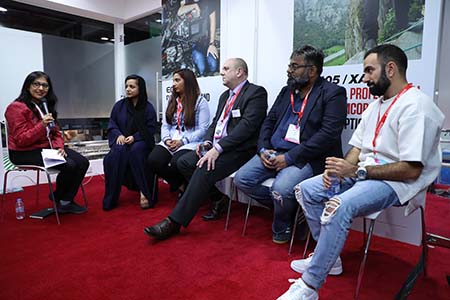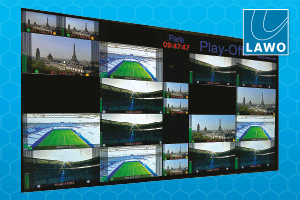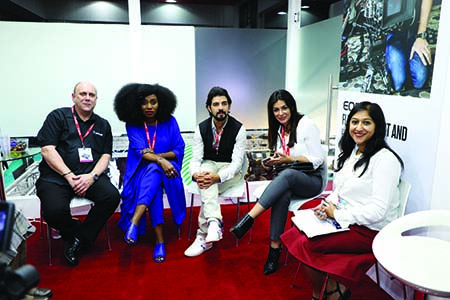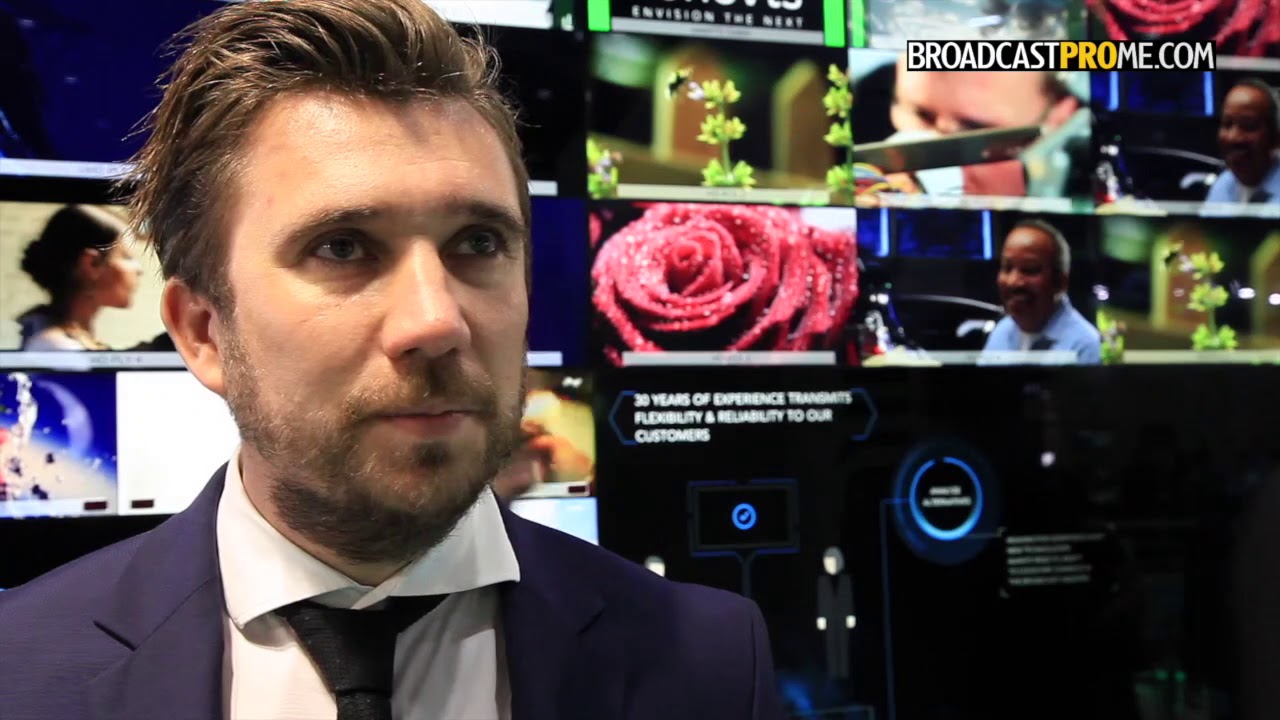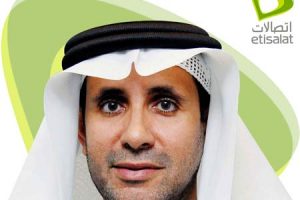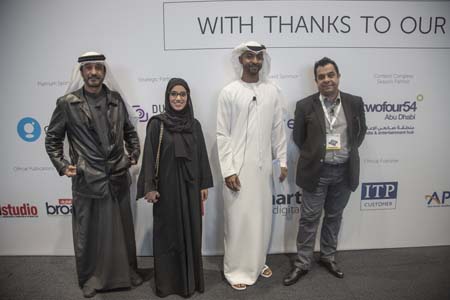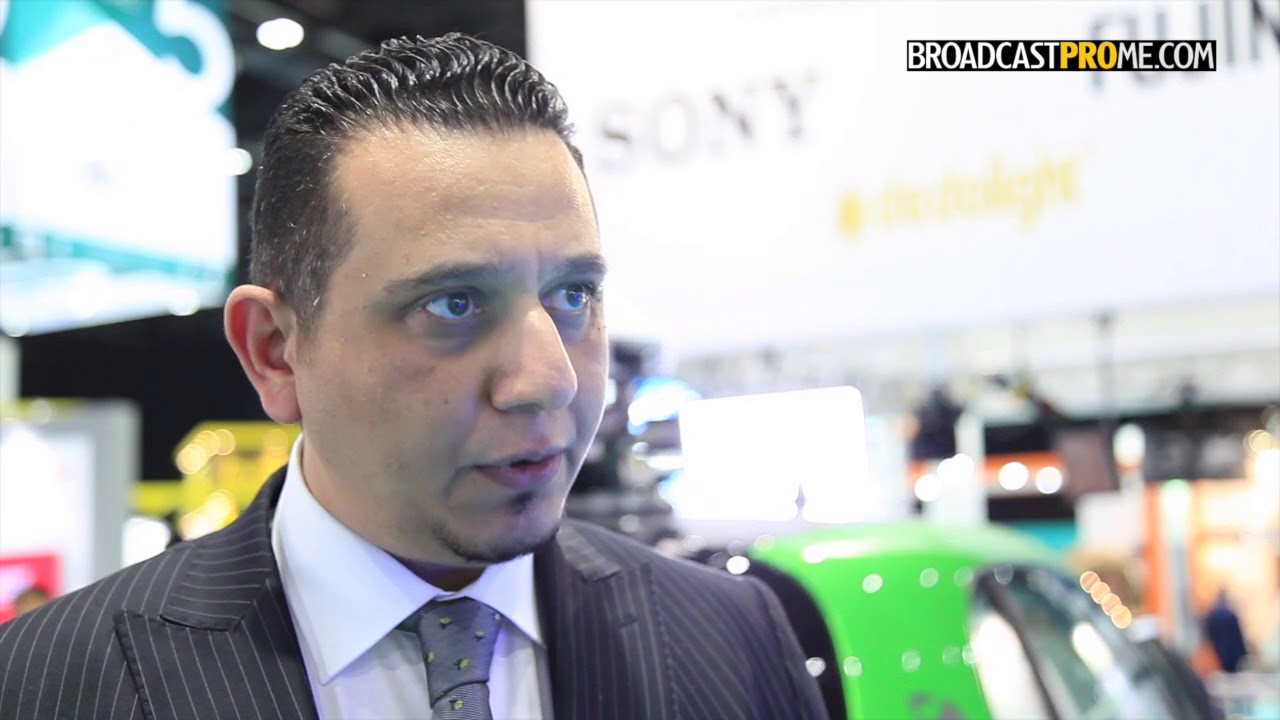Award-winning filmmakers and a celebrity YouTuber join the Canon panel to discuss factors that determine their choice of camera.
 Award-winning filmmakers and a celebrity YouTuber join the Canon panel to discuss factors that determine their choice of camera.
Award-winning filmmakers and a celebrity YouTuber join the Canon panel to discuss factors that determine their choice of camera.
An estimated 28% of the Middle East population is aged between 15 and 29, which represents over 108 million young people. Four in ten MENA residents watch videos online daily, and the region is ranked second in the world by the number of daily YouTube video views. In addition to this, mobile watch time in the MENA region is one of the fastest growing in the world, rising by 90% year on year.
Vijaya Cherian, Editor of BroadcastPro Middle East and moderator of the panel, set the tone for the discussion by pointing out how the above statistics have shaped video consumption trends in the MENA region, and in turn, impacted content creation for various platforms.
Canon brought together award-winning regional filmmakers and content producers to be part of this panel. On the one hand, we had Nayla Al Khaja, the UAEs first female film director and producer and Canons brand ambassador since 2011, and Reshel Shah, an independent documentary film director and senior film lecturer at SAE Dubai; while on the other, we had celebrity YouTuber Lowi Sahi and Jovan John, winner of the Dubai 48 Hour Film Project. Also joining the panel was Paul Atkinson, Product Specialist at Canon Europe for professional video and cinema EOS cameras.
What factors determine your choice of camera and how have your choices evolved with time? Vijaya asked the panellists.
Responding to the moderator with a nostalgic look at the simpler era of 35mm film, when there were fewer choices, Nayla Al Khaja outlined her approach to selecting a camera.

When the DSLRs came into the market, it was such a sensation, it revolutionised filmmaking. People began making home videos that didnt look like home videos any more. There was a slickness, a depth of colour and features that allowed for freedom of expression and creativity.
If I am filming content for YouTube or social media where I have limited resources and limited access to gear, I would use entry-level equipment that is lightweight, and one that has a flip screen. But if Im doing a high-end TV commercial or a narrative film that needs to look like it had more production value attached to it, I would go for high-end cameras that offer superior image quality both in terms of dynamic range and colour reproduction, among other aspects. Content and the platform determine the kind of gear I would use and, of course, the budget. Sometimes the variety available today can confuse budding filmmakers.
Documentary filmmaker and SAE lecturer Reshel Shah highlighted the empowering aspect of technology, given the sheer affordability of cameras.
Content and the platform determine the kind of gear I would use Nayla Al Khaja, Emirati Film Director and Producer

The DSLR revolution made filmmaking more affordable for us, especially with low-budget productions. If I want to make a film for social media or a small budget film, Im going to go with a good camera that offers full frame, high-resolution image capture, while being easy to handle. For my documentary features, I tend to film in India, generally in the villages. I cannot afford to take a big camera it would intimidate people.
Al Khaja interjected here to recall a film shoot with Reshel Shah in Oman: We were carrying this big camera in Oman. People thought we were holding a machine gun and started running away.
When wielding a big camera, people also think that you have more money, Shah observed. Cameras need to be easy to handle, while also giving us the depth and the colour we require. For documentaries especially, the ISO must be high because lighting conditions are often low.
Is there one camera that caters to all sorts of production needs, Paul Atkinson from Canon was asked.
The DSLR revolution made filmmaking more affordable for us, especially with low-budget productions Reshel Shah, Independent Documentary Film Director and Senior Film Lecturer at SAE Dubai
Ideally, you have to record for the highest definition possible. You cannot shoot on a smartphone and project it onto the big screen. You have an entire range of cameras, and it really depends on how you end up using that footage. What has surprised people the most is when they discovered that really high-end footage is sometimes being shot on DSLRs. That was the genesis of the whole C300 camera in 2011, which was designed to meet the demanding needs of modern moviemaking, Atkinson explained.
Among the most demanding of film productions is the annual 48 Hour Film Project, sponsored by Canon Middle East this year. In the recently concluded Dubai edition of the competition, Jovan Johns team and 28 other teams were supported during the 48-hour shooting period by Canon with equipment and services including camera loans, checking, cleaning and cinematography workshops.
Flexibility with price and technology is key, explained advertiser-turned-filmmaker Jovan, founder of Dubai media company Likewater Media.
As content creators and filmmakers, we are always on the look-out for flexibility in terms of price and technology. We use equipment that is appropriate for the medium, and it is great to know that if you have a vision in your mind, there is appropriate equipment to help you execute that vision.

For the 48 Hour Film Project, the organisers gave us a basic outline and we went on to develop it. It was comforting to know that there was a technical crew on standby to make sure everything was in order. If anything went wrong, we could always go to them.
Iraqi vlogger Lowi Sahi revealed that his online journey began when he responded in 2015 to a dying fans request to bring Dubai to her.
His weekly vlogging currently stands at more than 500 videos, with Sahi garnering a whopping 1.2 million YouTube subscribers. His skilled video productions are a far cry from the out-ofthe-bedroom videos normally associated with vloggers, indicating he is technically savvy.
According to Sahi, it is the 7D that changed the game on social media.
It was one of the first cameras where you could flip the screen, and suddenly, I had the power to talk and film. This camera was my route to vlogging, and not just for me but for a global community of vloggers. The PowerShot G7 X also has an incredible quality to it, and I felt I could shoot from the mountains to the water and nothing ever happened to the camera. Now it is on my wall. I have framed it because I made 500 videos with it and I reached one million subscribers with it, so Im very attached to it. Now I have 1.2 million subscribers.

We are a generation that wants to say what we think and how we see things, and everything is moving so fast that traditional television cannot keep up. It is very important for us to have these small gadgets to help us get there. Since we have elevated the quality of our work, my next purchase would be a camera with a significant increase in overall resolution and advanced processing engines. In my production house, we now do commercial work, documentaries and short movies. We use different cameras based on the platform for which it is being shot.
Creating a video for online subscribers is significantly different from shooting for the big screen, Nayla Al Khaja observed, citing the example of her experience shooting Malal, a story about arranged marriages in India. As Canons ambassador, she has also had the opportunity to try a range of the vendors cameras.
As a YouTuber, I used to film every day Life of the battery is a critical feature and the camera needs to be robust Lowi Sahi, Celebrity YouTuber
I have had the privilege of curating different cameras for different needs, whether its a high-end or a point-and-shoot kind of camera. Maybe Sahi has one million people watching one of his vlogs, and somebody else who has spent three years on one film has not had more than 300 people watch their film in the theatre. Then the question is, what is the right trend or direction to follow?
In my specific field, I think working with a DoP works best. We look at the story and what the scene demands. Is it a scene in a little room, or on a mountain top? Whatever the scene may be, the DoP will then come to me and say this is the gear we need, and these are the accessories we need to create that scene you envision as a director.
It becomes a dialogue between the DoP and me. In the film business, you cant have a oneman show as you would if you were shooting for social media. With Malal, we had a crew of 82 people. It was a huge undertaking. Of course, with the flexibility of social media and YouTube, you have great examples such as Casey Neistat, who have developed their own identity by creating content that is riveting. These are very interesting times.
The discussion then turned to how equipment has evolved over the years, and Atkinson used this opportunity to point out that compact cameras and a few features like auto focus were gaining more traction with content creators.
Commenting on autofocus, an innovation described as a paradigm shift in terms of efficiency and accuracy, Atkinson observed: Youll find that technology is making tools smaller. A feature such as autofocus, for my generation, was unheard of. It started with DSLRs, but it is now used in cinema cameras and is a feature that you can actually trust and use. Its called CMOS dual-pixel auto focus, which is very fast, very efficient, very effective and it can be trusted.

Its changing perceptions by giving filmmakers another tool. The downside, of course, is if you have a really usable autofocus, do you need a focus point? When you come to things like news gathering, people want something as small as possible. All cameras are now being developed with minimal build and a single shooter in mind. In newsgathering, its a journalist with a tripod and a camera, thats where the screen helps, so the journalist can position themselves, compose themselves and start recording the news.
Jovan added: While we love the manual focus aspect because its more engaging during filmmaking, I believe that online content creators such as Sahi would appreciate the autofocus feature that allows the shoot to get done quickly.
Reshel Shah, who is currently shooting a documentary on children with birth defects in India who are treated as if they are divine, highlighted how the newer, more compact equipment has helped her cause.
I just came back from India, filming my second feature film, called God Children. We were a crew of 12 including a DoP and two camera operators. The fact that we could go and make a whole feature film tells you how radically things have changed.
A few months ago, my DoP and I and the on-location sound recordist went to Ajman and took a DSLR and a tripod with us. We filmed a seven-minute short film and our budget was approximately $123. With the markets changing and budgets getting tighter, smaller teams for documentaries really help, and the gear has kept pace with our needs.
Al Khaja at this point gave us a reality check and cautioned that people who were receiving equipment free of charge were often forgetting to budget in the price of gear.
When someone gives you something thats sponsored, thats an asset. But you have to remember to plug that number in, because its not a reality. When you go out there with the bigger players for distribution, such as Netflix, everything is going to translate to a proper number. Its very important for us to train ourselves and understand the cost of the assets we have, whether its sponsored equipment or not. Time is just as valuable. When Im doing the budget, I actually include how much the equipment would have cost and how much my time is worth, so when someone says they did a shoot with $13 or $136, time should also be considered.
There are only three things that matter. Image quality, image quality and image quality Paul Atkinson, Product Specialist at Canon Europe for professional video and cinema EOS cameras
On the challenging transition from a non-commercial social media enthusiast to the owner of a production house, Sahi gave an insight into the adjustments he made along the way.
When I switched from vlogging to be the director of my own production house, I started to ask myself what I should pay myself. What do I put on the quotation? My brother helped me and brought a list of what production companies charge for. I saw ten jobs that I personally do, including being the DoP, director, the storyboard artist, colourist and the administrator sending emails.
While the industry is changing and budgets are lower, and brands are focusing on social media, we dont want to expand too much, to allow us to stay at a price range that can benefit the companies. We produce more and we produce quickly, and its all about networking in our field. If I had to hire someone, it would be an extra DoP for sure.
As a YouTuber, the quality is usually not that important either. At the end of the day, it is the message you want to put forward.
Drawing on her experience as a lecturer at SAE in Dubai, Reshel Shah seconded the need to stay focused on the content.
We tell our students that it is all about content what youre trying to show and what the message is. While the need to be a one-man crew is what the current economy demands, personally I will never be a DoP. It is not who I am. I am a film director and film producer of documentaries. I need my DoP with me, I need his advice. Thats why he is always there with me and explains to me why those cameras are needed or those lenses are needed.
We also try and teach the importance of working in a team to our students. Social media is growing, it is the place to be, but at the same time, cinema is not going to die either, so it is all about maintaining a balance going forward.
A whopping 90% of the viewers in the Middle East watch content on their mobile phones. I need to keep that in mind even when I am shooting for the large screen. Also, subtitling in the same language helps increase viewership by 25%, because a lot of people dont listen, they read the content.
As content creators and filmmakers, we are looking for flexibility in terms of price and technology Jovan John, founder of Dubai media company Likewater Media
The hour-long discussion, which touched upon several topics including the first cameras of the panelists and how they slowly started to pick and choose their equipment over the years, finally concluded with the moderator asking the participants what their dream camera would look like.
Al Khaja pointed out that for her, size would be a huge deciding factor.
I would like my camera to be as small as my palm, with the same professional features as the large cameras. That would definitely be a dream gadget to have, and Im sure were not very far from achieving that.
Reshel Shah concurred: The smaller the better. A few years ago, I stayed in the slums of Mumbai for 40 days and people were staring at us as we shot in the narrow lanes. Production-wise, it is always more convenient to have a lightweight, smaller camera. The cameras are already getting there, with 4K and better performance in low light.
The winner of the 48 Hour Film Project, John said his dream camera would be an invisible camera.
A camera that is not obtrusive and doesnt look like a machine gun. Service and support are very important, and that is the only way any brand can move forward. Just putting a product in front of you is not going to do much, especially if you are looking for long-term users. I think that as part of the 48 Hour Film Project, we definitely got that.
I would go completely off the ball, commented Atkinson, and have a camera with very fine film as well as a digital sensor. That would be my dream camera, but it will not be the size of your hand. Realistically, my dream camera already exists.
I am very happy with the cameras I have, Sahi observed, adding that on social media, the ease with which you can reach your audience is more critical. He recalled a recent segment he filmed aboard an Emirates A380.
Now we have in-flight WiFi, which we did not have earlier. Also, as a YouTuber I used to film every day for two years, which meant battery life was crucial and robust cameras are essential.
Turning to his fellow panellists, who have taken the more traditional route towards creating content through feature films and documentaries, Sahi suggested more collaboration. As content creators for social media, I dont believe our intention is to take over the cinema and the documentary side of content creation. I believe there is huge potential if we collaborate and create content for online platforms such as Netflix and others.
